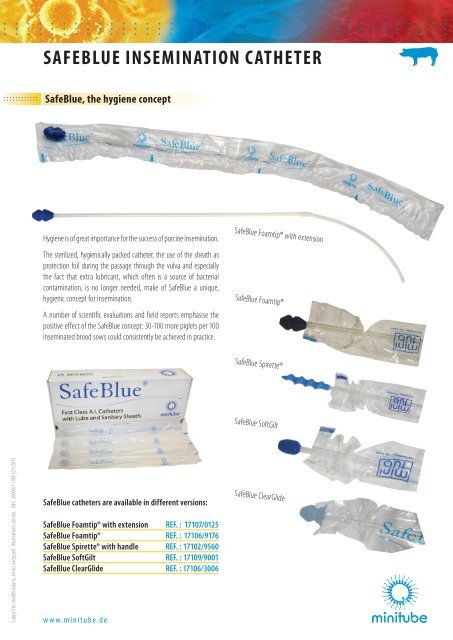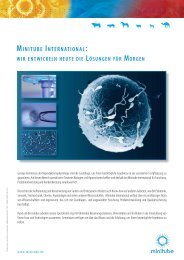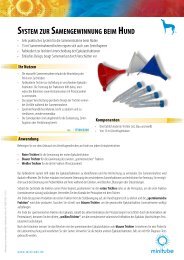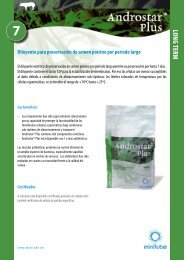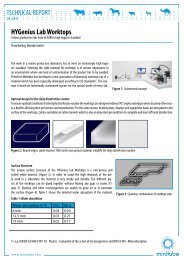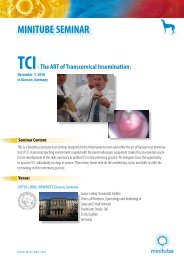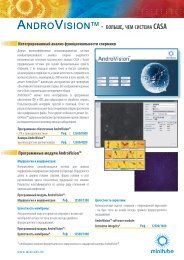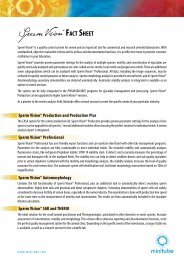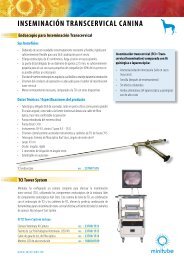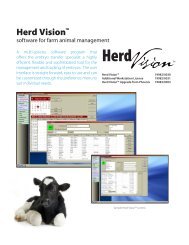Safeblue InSemInatIon Catheter
Safeblue InSemInatIon Catheter
Safeblue InSemInatIon Catheter
Create successful ePaper yourself
Turn your PDF publications into a flip-book with our unique Google optimized e-Paper software.
::::::::::::<br />
Subject to modifications, errors excepted. Illustrations similar. REF.: 30000/11184 | 01/2013<br />
<strong>Safeblue</strong> <strong>InSemInatIon</strong> <strong>Catheter</strong><br />
<strong>Safeblue</strong>, the hygiene concept<br />
Hygiene is of great importance for the success of porcine insemination.<br />
The sterilized, hygienically packed catheter, the use of the sheath as<br />
protection foil during the passage through the vulva and especially<br />
the fact that extra lubricant, which often is a source of bacterial<br />
contamination, is no longer needed, make of SafeBlue a unique,<br />
hygienic concept for insemination.<br />
A number of scientific evaluations and field reports emphasise the<br />
positive effect of the SafeBlue concept: 30-100 more piglets per 100<br />
inseminated brood sows could consistently be achieved in practice.<br />
SafeBlue catheters are available in different versions:<br />
SafeBlue Foamtip® with extension REF. : 17107/0125<br />
SafeBlue Foamtip® REF. : 17106/9176<br />
SafeBlue Spirette® with handle REF. : 17102/9560<br />
SafeBlue SoftGilt REF. : 17109/9001<br />
SafeBlue ClearGlide REF. : 17106/3006<br />
www.minitube.de<br />
SafeBlue Foamtip® with extension<br />
SafeBlue Foamtip®<br />
SafeBlue Spirette®<br />
SafeBlue SoftGilt<br />
SafeBlue ClearGlide
:::::::::::: Your benefits<br />
Very clean insemination with little efforts.<br />
• The sterilised catheter remains clean and free of contaminants<br />
during storage until insemination.<br />
• Because of the protective sanitary sheath, the catheter remains<br />
clean during the insertion in the vulva after which the catheter<br />
tip is pushed through the sheath.<br />
• No more fumbling with lubricants<br />
• Improved pregnancy rates and litter numbers<br />
:::::::::::: application<br />
• Clean the outside of the sow’s vulva with a dry paper towel.<br />
• Introduce the catheter with the sanitary sheath 5-10 cm; then<br />
push the catheter tip through the sheath<br />
• Pull the sheath backwards<br />
• Screw off the tip of the QuickTip tube and lock it in the catheter<br />
shaft with a quarter of a turn. Start the A.I.<br />
:::::::::::: literature<br />
Hoy, S., De Alba, C. (2005): Minimizing the risk of contamination<br />
during artificial insemination improves reproductive results in sows.<br />
Reproduction in Domestic Animals Vol. 40, No. 4, pp 390.<br />
Hoy, S., De Alba, C. (2005): Improvement in breeding results by<br />
technician skills and hygiene during routine artificial insemination<br />
of sows. Proceedings of the 7th International Conference on Pig Reproduction,<br />
Kerkrade, The Netherlands, pp 134.<br />
Better hygiene during AI improves fertility (2004). International Pig<br />
Topics, Volume 19, No. 6.<br />
Heinze, A. (2006): „Mehr Aufmerksamkeit für Besamungshygiene.“<br />
Thüringer Landesanstalt für Landwirtschaft<br />
Hoy, S. (2005a): Die „sterile“ Besamung – Eingeschweißter Besamungskatheter<br />
erhöht die Abferkelrate. BLW 2.<br />
www.minitube.de<br />
Improved pregnancy rates<br />
through artificial insemination<br />
with <strong>Safeblue</strong>-catheters<br />
91,8 %<br />
1031<br />
Piglets<br />
80,6 %<br />
890<br />
Piglets<br />
141 more piglets per 100 inseminated sows<br />
-> 1.41 more piglets per sow (+15,8 %)<br />
In the field trial of Hoy et al. (2005a), 141 more piglets per<br />
100 sows were achieved by using SafeBlue, compared to a<br />
conventional insemination catheter.<br />
Hoy, S. (2005b): More piglets with a single wrapped sterilized catheter.<br />
Pig Process, Volume 21, No. 8.<br />
TA Temmen, F. (2003): Erfahrungsbericht zum Besamungskatheter<br />
“SafeBlue“. BES Golzow, Deutschland.<br />
Reicks DL (2003): Bacterial contamination and semen quality. Proc.<br />
Allen D. Leman Swine Conf., 169-170.<br />
Thompson, R. (2000): Transportation, cleaning and disinfection<br />
swine health fact sheet. Vol. 2, n°2, January, NPPC.<br />
De Winter PPJ, Verdonck, M., de Krief, A., Devriese LA, Haesebrouck<br />
(1992): Endometritis and vaginal discharge in the sow. Anim<br />
Reprod Sci; 28: 51-58.


